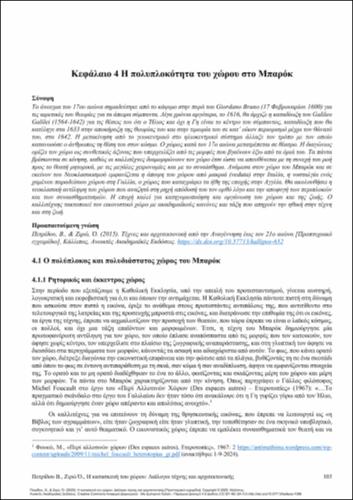| Title Details: | |
|
The complexity of space in the Baroque |
|
| Authors: |
Petridou, Vassiliki Ziro, Olga |
| Keywords: |
Multiaxiality
Emotional naturalism Theatricality The diagonal The space of nostalgia The space of Neoclassicism Scale Measure Proportions Clarity |
| Description: | |
| Abstract: |
Chapter 4 explores the multisensory visual space of the Baroque era. From painting and sculpture to illusionistic frescoes and ceiling decorations, space is transformed into a theatrical, phantasmagorical realm—one in which forms appear to break free from their boundaries and actively invade the viewer’s space. This dynamic, multiaxial spatial experience—characteristic of the Baroque—comes to an end with the rise of Enlightenment rationalism and the aesthetic principles of Neoclassicism. In contrast, Neoclassical space is governed by restraint, order, and clarity, reflecting the moral ideals and civic virtues associated with the "good citizen."
|
| Linguistic Editors: |
Konachos, Dimitrios |
| Technical Editors: |
Konachos, Dimitrios |
| Graphic Editors: |
Kaitsa, Elena - Natassa |
| Type: |
Chapter |
| Creation Date: | 31-07-2025 |
| Item Details: | |
| License: |
Attribution - NonCommercial - ShareAlike 4.0 International (CC BY-NC-SA 4.0) |
| Handle | http://hdl.handle.net/11419/15033 |
| Bibliographic Reference: | Petridou, V., & Ziro, O. (2025). The complexity of space in the Baroque [Chapter]. In Petridou, V., & Ziro, O. 2025. The construction of space: dialogues between art and architecture [Undergraduate textbook]. Kallipos, Open Academic Editions. https://hdl.handle.net/11419/15033 |
| Language: |
Greek |
| Is Part of: |
The construction of space: dialogues between art and architecture |
| Publication Origin: |
Kallipos, Open Academic Editions |

